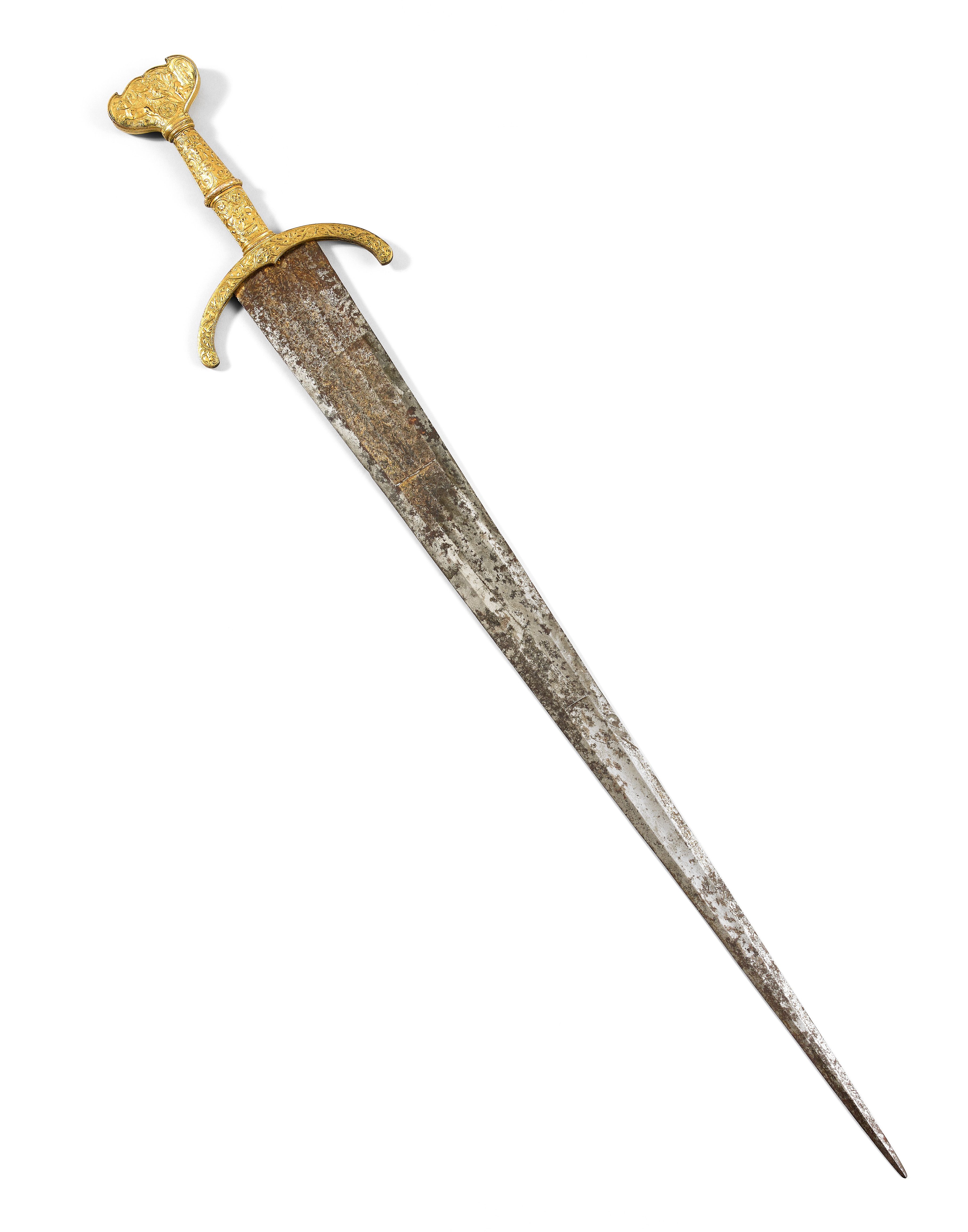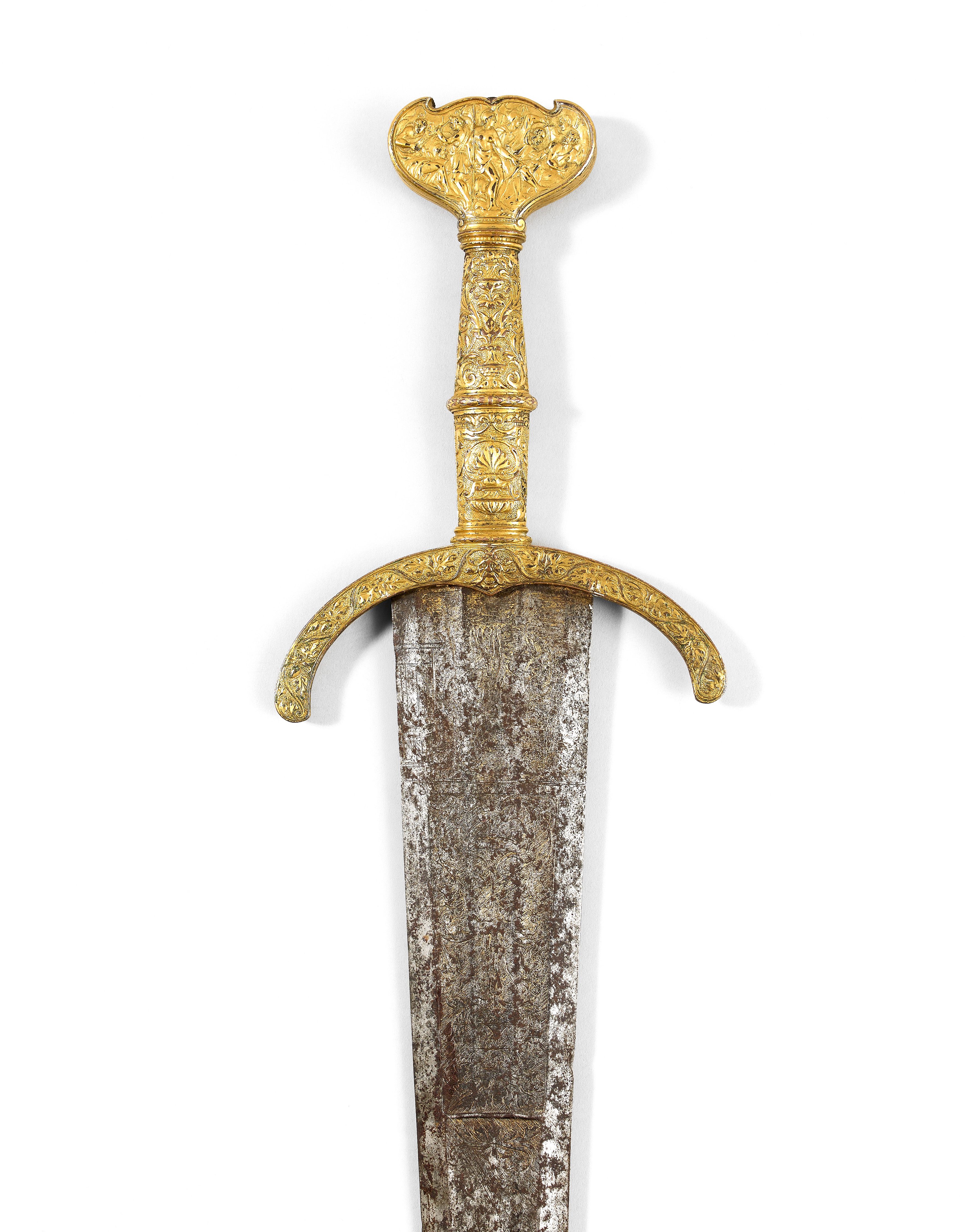Exceptional discovery of a noble sword of the Cinquedea type
Live with us the discovery of an exceptional sword dated between 1490 and 1510 (Florence) of type Cinquedea, sold on March 31 at Drouot

On March 31, 2023, a rare find will be honored and sold under the hammer of Maître Béral at Drouot. This noble sword of the Cinquedea type has been authenticated by a private individual living in France.
This lot has been authenticated by Auctie's team and the expert in Antique Weapons, Alban Degrave, 06 59 66 40 40.
To make an appointment to see this sword in preview, click here.
Attributed to Northern Italy, 1490-1510.
The engravings on the blade are similar to those produced in the workshop of the Ferrarese goldsmith Ercole dei Fedeli, who was active in the late 15th and early 16th centuries. Close to the circles of Italian power, particularly that of Isabella d'Este and the court of Mantua, his work as a "sword engraver" is mainly known for its figures evolving in complex, ancient-style architectural spaces, medallion figures combined with foliage and grotesques.


Global typology
From a typological point of view, the sword is similar to the Cinquedea, a short ceremonial sword with a flat triangular blade marked by flutes. Exclusively worn in civilian contexts, it had a brief success among Italian princes during the Renaissance around the turn of the 15th and 16th centuries. The blades were often richly decorated with ornamental motifs popular at the time, as well as allegorical and mythological scenes intended for a refined and cultured audience capable of perceiving their meaning.
Based on the example preserved at the Louvre Museum (inv. MRR 58), that of the Metropolitan Museum of Art in New York (inv. 14.25.1172), or that of Cesare Borgia's sword preserved at the Casa Caetani, it seems that there may have been a rare production of similar weapons in elongated versions.
As Eugene Muntz writes in "Les épées d’honneur distribuées par les papes" (The Honor Swords Distributed by the Popes), 1895:
"The Pope offered 'swords of honor' every year, and they were characterized by works of art in the strongest sense of the term: chiseling, damascening, enameling, competed in precision and elegance; exquisite foliage alternated with subtle allegories or inscriptions in beautiful Ciceroan Latin. First and foremost, note the originality of their form and decoration: these weapons were intended to be held with both hands, the point in the air..."
Ewart Oakeshott classifies the blade in type XXI.I and the guard in type IX. "Seems typically 15th century despite some examples known from the 13th century. The arms form a ribbon that is perpendicular to the plane of the blade."

The Mount
Materials
The sword's mountings are made of gilded copper and bronze.
The pommel
The rivet button is visible at the top of the pommel. The cartridge is made up of two embossed, chiseled, and gilded bronze plates set in a gilded bronze belt.
On one side, Minerva in the center of a fight.
On the other, Victoria or Nike is depicted on a chariot of triumph with an eight-branch solar wheel, preceding Fame sounding her trumpet.
- Related work:
A representation of the Judgment of Paris NI: 1942.9.207 is present in the collections of the National Gallery of Art Washington on a sword pommel plaque.
This scene is also engraved on the blade of our sword.
- Symbolism:
Minerva, goddess of wisdom and war. Fama, goddess of fame, making heroes immortal, never letting their memories die.
The Roman triumph was a Roman ceremony in which a parade was organized in which the victorious general paraded on a chariot at the head of his troops.
The four-axis and eight-branch solar wheel is a symbol of the sacred division of space and time.
The four-axis and eight-branch solar wheel is a symbol of the sacred division of space and time.
Associated with the triumphal chariot, it can represent temporal power.
We can assume that the recipient of this artwork experienced a battle that he won through his strategic talents, giving him a position of power in the city and triumph in his victory.
The grip
In gilded copper.
Made up of two halves held together in the center by a laurel wreath crown ring.
The two ends are held inlaid in the pommel and the guard. It features a candelabrum and bucranium decor.
- Related works:
The same type of composition can be found in an etching printed in Florence dating from 1470-1490 reproduced in the book “Les premières gravures italiennes” (The first Italian engravings) by Gisèle Lambert.
It is preserved in the BNF, Florence, Ornaments, Cat 216-276.
“Burin en manière large” (Large manner burin) 262X46. Around 1470-1490.
- Symbolism:
The bucranium is a canonical ornamental design of the ancient Doric order taken up from the Renaissance evoking the remains of animals sacrificed in honor of the gods. It should be noted that the Doric order was often associated with heroic figures and male divinities in the Renaissance due to the writings of the Roman architect Vitruvius. This could explain the choice of this design on the handle. Such weapons were intended for a learned audience and were meant to demonstrate this erudition.
The guard
Assembled copper plates, chiseled and gilded.
Two curved quillons in half-moon shape, slight asymmetry that can be found on the sword of Caesar Borgia, preserved in the Bargello Museum as well as on that of the Louvre Museum.
In the center, a decoration of grotesques and vine leaf on branches friezes.
Related work:
Sword, around 1500/1600 Louvre Museum MRR 58; P 280 303.

The blade
Triangular in shape and double-edged. It has three channels at the heel, two in the center, and one in the last third. Reinforced tip in mail-piercing type thrust.
Presence of a forge mark.
The engravings
Highlighted in gold, they extend from the heel to the third of the blade.
The most notable element is the presence on one of the faces of an important scene depicting the judgment of Paris. In this famous mythological episode prefiguring the Trojan War, the Trojan prince Paris is entrusted by Jupiter with the task of designating the most beautiful of the goddesses among Juno, Minerva, and Venus in the context of a conflict that opposed them following the machinations of the goddess of Discord. Brought by Mercury to the top of a mountain, Paris awards the golden apple to Venus, who promises him the hand of the most beautiful woman in the world, Helen, wife of the king of Sparta Menelaus, an event that will precipitate Greece into war.
The scene shows the young prince in heroic nudity, holding the apple of discord in his hand, sitting in front of the three naked goddesses. The scene is framed by an "antique" architectural structure on the right and a wood on the left. The general composition evokes the lost work of Raphael (1483-1519), known through engravings made by Marcantonio Raimondi (1480-1534) since 1514.
The "judgement of Paris" was a recurring motif during the Renaissance, a period in which a new humanistic culture emerged that drew on the Greco-Roman antique heritage. The subject was imbued with complex and sometimes gallant philosophical symbolism, serving as a pretext for the exhibition of nude bodies. It is regularly present in the domain of European armor and weapons intended for display, as can be seen on a cinquedea present in the collections of the Army Museum in Paris (inv to be specified). These weapons, often gifted, were carriers of a decoration appreciated for its ability to delight the senses and exhibit refinement, culture, and even the real or supposed ability to grasp hidden messages. It is therefore not insignificant to find it on such a blade.
On the other side, near the heel, in a medallion, is the profile of an emperor with a laurel wreath under a candelabrum flanked by two putti, all topped by a naked female figure, logically Venus if we refer to the general iconography of the blade, the one designated as the most beautiful by Paris.
On both sides of the blade, the engraving stops at a bevel, another characteristic of the cinquedeas on which an asymmetry of the decoration is often notable.
Dating and location
The dating and location of this piece are established in this notice from the elements that we have at our disposal, leading us to the conclusion of a high probability for a North Italian production from the late 15th or early 16th century.
Technical data
Length of the blade: 86 cm.
Total length: 106 cm.
Balance point: 15 cm.
Weight: 1330 grams.
Oxidations.
Acknowledgements
We would like to express our special thanks to Mr. Philippe Malgouyres, Chief heritage curator at the Louvre Museum, for kindly receiving us and exchanging information about this sword.
Register with your e-mail address to receive catalogues of our future sales.